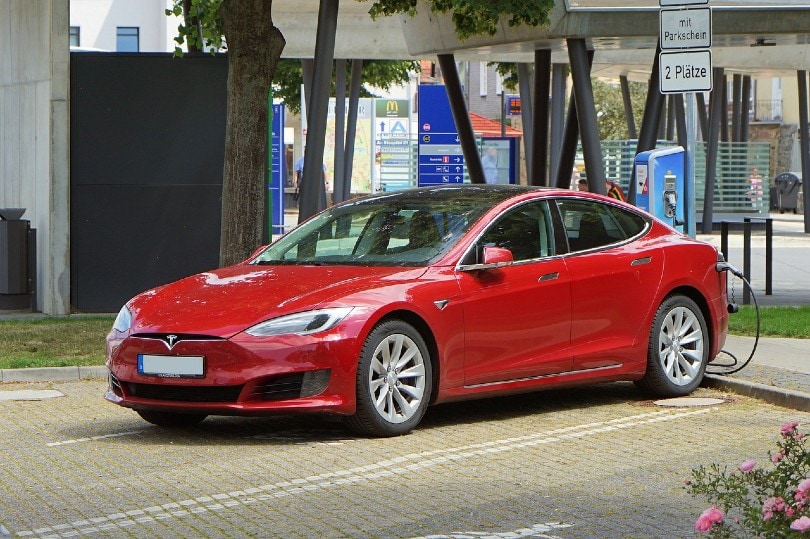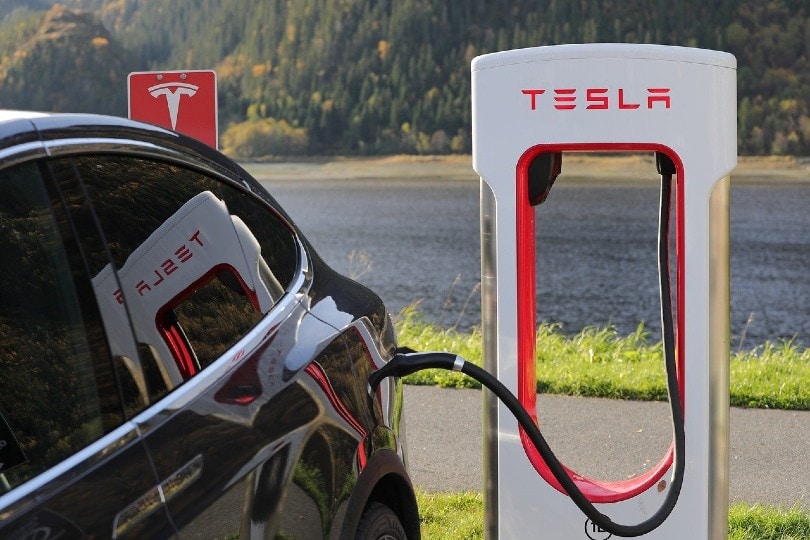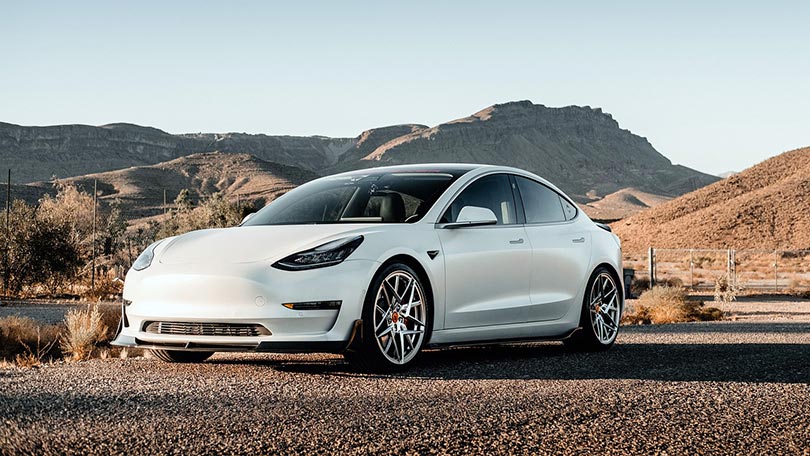How Much Electricity Does a Tesla Use? Everything You Need to Know!
-
- Last updated:

These last couple of years, Tesla has been “crushing it” on the EV market. Their cars are fast, tech-packed, and fun to drive. And, thanks to the company’s forward-thinking technology, the batteries last for decades. Now, no Tesla vehicle needs gas. Instead, they rely solely on batteries to run. So, how much electricity does a Tesla need? On average, Elon Musk’s trailblazers use 34 kWh per 100 miles.
The actual consumption varies depending on the vehicle, of course. In this guide, we’ll go over different Tesla cars, how much electricity each model needs, the total range, and how they compare to other popular EVs. We’ll also talk about the best techniques for minimizing energy usage and increasing the lifespan of a Tesla.

What Is a Tesla? How Does It Work?
Tesla is a company that specializes in the manufacturing of electric vehicles. They also build energy generation/storage solutions like solar roofs and solar panels, but this brand is mostly famous for best-selling nameplates like Model Y and Model 3. So, how do these vehicles work, exactly? Well, just like any other EV, Tesla cars don’t have a “traditional” engine.
Instead, they rely on electric motors to do all the heavy lifting. And it’s the battery’s job to power those motors up. That means you’ll have fewer parts to repair or replace. On top of that, electricity costs significantly less than gas. In the long run, that amounts to thousands of dollars saved. Tesla vehicles are sleek, quick to accelerate, and come packed with a wider range of features.

What’s the Average Tesla Electricity Consumption?
There are four cars in the Tesla line-up, available in various configurations. And, on average, they consume 34 kWh per 100 miles. As for the total range, you can expect a Tesla to go for 300–400 miles on a single battery charge. This is quite an impressive result, given that the median average range for an EV last year was 234 miles (68 miles back in 2011)! That’s one of the reasons why Tesla vehicles are so popular today.
But, every Tesla model is different. For example, Model X, the company’s crossover SUV, uses 33–37 kilowatt-hours per 100 miles, while Model 3, the best-selling EV in 2021, is good for 25–30 kWh/100 miles. Here is a more detailed breakdown of all four vehicles and their estimated electricity usage and total range. Check it out:
| Tesla Car Model | Electricity Usage | Total Range | Annual Electricity Cost |
| Model S | 28–33 kWh/100 mi | 348–405 miles | $550–650 |
| Model 3 | 25–30 kWh/100 mi | 272–358 miles | $500–600 |
| Model X | 33–37 kWh/100 mi | 311–348 miles | $650–700 |
| Model Y | 26–30 kWh/100 mi | 279–330 miles | $500–600 |
What Makes a Tesla Use More Energy?
The main factor that affects energy consumption is the speed of driving. The faster you drive, the more power the Tesla will use. Uphill driving has a similarly negative effect while driving downhill helps save and even regain energy. The environment has a say in this as well. Extremely hot or cold weather makes the motors work harder. The same is true for wind (when the car is driving against it, that is, not being pushed by it).
And let’s not forget the battery size: the smaller it is, the weaker the charge will be. Next, if you turn the climate controls up to make the cabin warmer or colder, expect the battery charge to be drained more quickly. Tesla owners that do a lot of stop-and-go driving will also deplete the batteries. Rolled-down windows, heavy cargo, and misaligned tires are even more factors affecting performance/charge, but they’re not as significant.
Tips for Reducing the Appetite
So, is there a way to make a Tesla last longer? Yes, there are certain things you can do to enjoy longer commutes on a single charge. While this might not be particularly fun, if you adhere to certain tips and tricks, you will be able to maximize the range. In many ways, the following recommendations apply to gasoline-powered cars as well:
- Try not to accelerate too much, slow down when you can. The Speed Assist and Chill Mode will help you with that
- Avoid using the brake pedal when bringing the car to a stop. Instead, modulate the accelerator pedal
- Heating for the steering wheel and seats requires less energy than climate control—keep that in mind
- Don’t forget to precondition the Tesla using the dedicated app while it’s still charging
- Use the Schedule function to “tell” the system when you need the vehicle to be ready for you
- Take advantage of regenerative braking by switching to Hold in the Stopping Mode settings
- Turn off features that may negatively affect the range. These include Cabin Overheat Protection and the Sentry Mode
- Make sure the wheels are aligned, rotated, and pumped with just the right amount of air
- To battle wind resistance and enjoy the benefits of aerodynamics, install Tesla aero covers
- Don’t carry heavy stuff in the back unless you absolutely have to
- Fight the urge of using DC chargers to keep the battery healthy
- Make a habit of keeping the charging cable plugged in when the Tesla is in idle mode

How Do Tesla Cars Compare Against Other EVs?
Ok, now that we know how much electricity each Tesla model consumes, let’s take a quick look at how they compare to some of the best-selling vehicles on the market. The following list stacks Tesla against the likes of Chevy Bolt, Nissan Leaf, and other top-notch EVs:
| Vehicle | Electricity Usage | Total Range | Annual Electricity Cost |
| Tesla Models | 34 kWh/100 mi | 300–400 miles | $550 |
| Chevrolet Bolt | 28 kWh/100 mi | 259 miles | $550 |
| Nissan Leaf | 31 kWh/100 mi | 226 miles | $600 |
| Mercedes-Benz EQS450 | 35 kWh/100 mi | 350 miles | $700 |
| MINI Cooper SE Hardtop | 31 kWh/100 mi | 114 miles | $600 |
Are Teslas Worth It?
The most important thing to understand about a Tesla is that it’s NOT an affordable vehicle. This is especially true for the Model X that’s currently available for $100K+. Model Y, S, and 3 are also relatively expensive and cost more than $50K (unless you buy a used one for cheap). That makes a Tesla a luxury car. On the bright side, you won’t have to spend big bucks on gasoline.
On average, Teslas consume $550 worth of electricity a year. Compared to how much you’ll spend on gas on a Toyota Camry ($1–2.2K, depending on the tier), that’s a pretty big difference. Still, you’ll have to wait for a very long time before Tesla starts paying for itself. So, only consider buying one if you can afford it and if you care about the environment. Otherwise, a Bolt or a Leaf will be a better investment.
How Long Do the Batteries Last?
According to the SEO of the company, Elon Musk, the battery packed inside of a Tesla Model 3 can last for 300–500K miles or approximately 1.5K cycles/20–36 years. More importantly, the batteries retain 70–80% of their capacity after you drive for 200K miles, which is quite an impressive result for an electronic vehicle. To back those claims, Tesla covers its cars with decent warranty deals.
Model Y Performance comes with an 8-year/120K miles guarantee, while Model S and Model X are covered by an 8-year/150K miles guarantee. And to replace the battery module, you’ll only have to pay $5–7K—more than a fair price. The lifespan will depend on the weather, your driving style, maintenance, and other factors, but you can expect to get at least 200–300K miles out of a brand-new Tesla battery.
Tesla Maintenance 101
It’s safe to say that Teslas are among the most reliable and long-lasting electric vehicles out there. However, just like any other car, they do require regular maintenance. And the best thing about a Tesla—it doesn’t require emissions checks or fluid changes. You won’t have to replace the spark plugs or fuel filters, either. The brake pads, in turn, last significantly longer due to reduced wear.
In addition, thanks to the company’s dedicated app, you can get quick software updates and remote diagnosis (through the company’s service technicians) without ever leaving the house. With that said, do keep in mind that maintenance/repairs at a third-party auto shop might affect the warranty. Servicing at a Tesla shop won’t void the warranty, of course. And here are official Tesla recommendations on maintenance:
| Cabin air filter replacement: | Once in 2 years (3 years for Model S and X) |
| HEPA filter replacement: | Once in 3 years |
| Tire rotation/alignment: | Every 6.2K miles (or when the tread depth difference is 2/32 inches) |
| Brake fluid test: | Once in 2 years |
| Brake caliper lubrication: | Once a year/as needed |
| Wiper blades: | Once a year/as needed |
| A/C desiccant bag replacement: | Every 3 years (4 years for Model Y; 6 years for Model 3) |


Conclusion
It’s hard to overestimate Tesla’s influence on the industry of electric cars. Tesla Model Y and 3 are constantly topping the charts; the company’s annual sales are just as impressive. One of the best things about a Tesla car—you don’t have to pump it with gas. That equals less money spent every year on consumables. You do have to keep the battery charged, though.
But, Teslas have surprisingly low electricity usage for their size. As we learned today, compared to some of the most efficient electric vehicles out there, Tesla models hold their own. And with the electricity bills in the US going through the roof, knowing that your EV won’t leave your wallet empty is a big pro!
- Elon Musk – Model 3 Battery Module Lifespan
- Tesla Environmental and Product Impact Report
- EnergySage – How long does a Tesla battery last?
- Gov – Bolt vs. Leaf vs. EQS vs. Cooper
- Statista – Best-selling plug-in EVs worldwide in 2021
- Gov – Median and Maximum EV Range
- Tesla Model X Overview – Order Price
- Gov – Toyota Camry MPG
- Com – Getting Maximum Range
- Gov – 2022 Tesla Model S
- Gov – 2022 Tesla Model 3
- Gov – 2022 Tesla Model X
- Gov – 2022 Tesla Model Y
- Tesla Maintenance Service Intervals
- Tesla Support – Car Maintenance
- CarStuff – Do Teslas Have Engines?
Featured Image Credit: webandi, Pixabay
Contents

